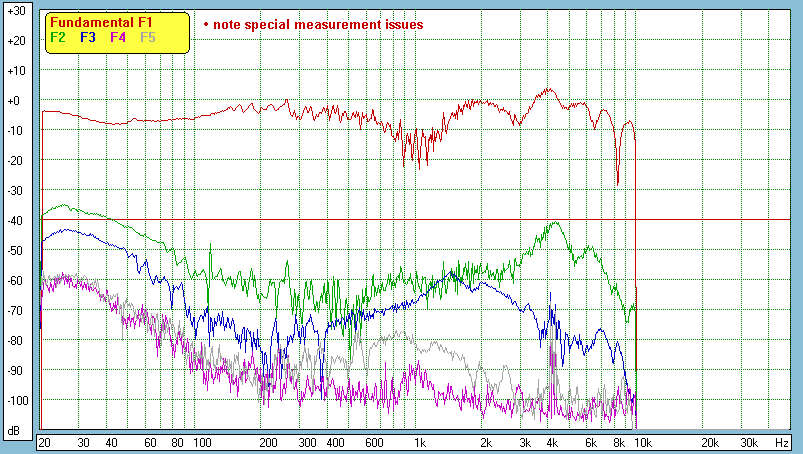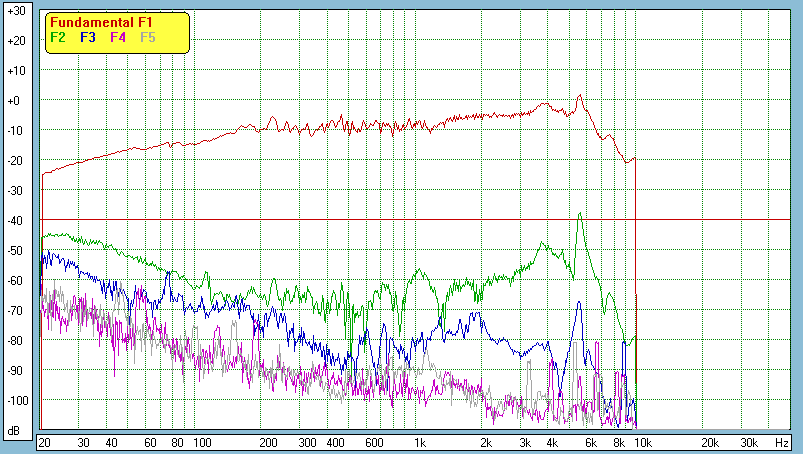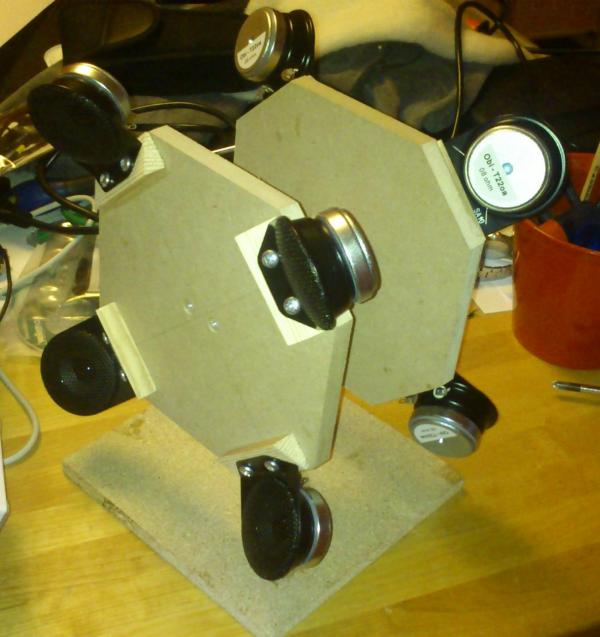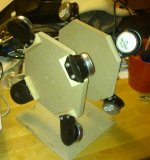And after gradient losses we're probably looking at even less!
FWIW the Seas M15CH002 is pretty damn good....
A 6.5 inch driver playing up to 2khz? No offense, but I think your design has some priority issues....
It doesn't seem measure that well though : /
In Zaphs 5 inch test the hexadym measures about the same as their normal magnet. And in his test with the W18NX compared to the 6ND430 is has way more odd harmonics, less xmax and less sensitivity.
The issue is the rear magnet of the 6ND430, but that might be able to be compensated hence this thread =)
In terms of importance, the forward horizontal polar / power response eclipse the back wave 0 deg response (your apparent focus).
Why not use an actual dipole driver, like the BG Neo 8 in free air? There will be no magnet structure to worry about.
The problem with them is that they only have horizontal dispersion, they are not point sources which is is what I'm trying to build.
If I wanted a line source I too would just get an RD-75 and call it done
If directivity at 2 khz becomes too much of a problem I could probably cross lower, I'm off tomorrow to buy one of the tweeters I plan to use to measure myself and see how it works.
What makes me hope that the 6.5 inch driver can work up to 1800-2000 hz is the dipole peak, if the driver is used without a baffle then according to Edge the dipole peak should be right in the middle of 1800-1900 hz.
What makes me hope that the 6.5 inch driver can work up to 1800-2000 hz is the dipole peak, if the driver is used without a baffle then according to Edge the dipole peak should be right in the middle of 1800-1900 hz.
It has been discussed before on this forum that the dipole peak of a nude driver will happen somwhat lower than expected, because the effective path length will be greater than just the diameter of the driver chassis.
This is a measurement of a Seas W15CH001 5" midrange, dipole with no baffle. Dipole peak around 1600 Hz....
This is a measurement of a Seas W15CH001 5" midrange, dipole with no baffle. Dipole peak around 1600 Hz....
An externally hosted image should be here but it was not working when we last tested it.
It doesn't seem measure that well though : /
Where was it measured? And which parameters relevant to perception were measured?
In Zaphs 5 inch test the hexadym measures about the same as their normal magnet.
And in his test with the W18NX compared to the 6ND430 is has way more odd harmonics
Um, sure, Here is the W18NX:

and the 18 sound

All distortion for both drivers is less than 50db below the fundamental in the relevant passband for a 6.5" driver mated to a flush tweeter (< 1.6khz). Neither motor exhibits any untoward issues.
The rising 3rd and 4th harmonics for the Seas are not flux or motor distortion (IE anything that might indicate increasingly audible consequences as SPL rises); they are a function of the rising frequency response magnitude caused by the cone material. It's not a perfect driver, but it's got a very good motor that keeps non linear distortion well below audibility in its passband.
No conclusions WRT sound quality or usefulness can be drawn from these H.D. charts between these two drivers, unless you listen with your eyes and not your ears.
less xmax
Does, and How does he actually test xmax? Or are we comparing manufacturer spec - of which there are a billion different methodologies for coming to an arbritrary xmax number for the spec sheet? Either way though, the W18 Nextel somehow according to zaph has two more mm xmax than the 6ND430.
less sensitivity.
Well yes! The W18 uses a heavy (pistonic) magnesium cone and the driver as a whole has been very well damped with SQ and extension as a priority.
You put a light paper cone on that motor and optimize the soft parts for output over excursion, you'll get your sensitivity at the cost of xmax and possibly resolution - as John Janowitz' measurements of the 18sound show:
You've got a bunch of unaddressed resonances. They may not look bad on the "harmonic distortion" chart but unlike the HD, these may be evident in listening as a smearing of the sound. Here is the impedance closeup of the M15's sibling the W15LY:

To me it looks like it probably has less any visible resonances.
It really doesn't affect me which driver you want to use, as I'll just have fun reading the thread etc, but I think you should be careful when you say x measures better than y. Not everyone thinks Zaph Audio measurements are the holy grail, or even that they correlate well to subjective impressions. They'll separate the wheat from the chaff and they can be used to derive FRD files but that's about it.
Anyways the M15 is a ~5 inch driver rather than an ~6.5" driver like the 18 sound. So you will lose some efficiency (about 3-4db? ). it's one price to pay for wider or more dipolar dispersion.
The issue is the rear magnet of the 6ND430, but that might be able to be compensated hence this thread =)
And that "issue" could be addressed well........ with that "measures the same" hexadym neo magnet

Last edited:
The problem with them is that they only have horizontal dispersion, they are not point sources which is is what I'm trying to build.
huh? the Neo8 is virtually the same hieght as a 6.5 inch driver, give or take an inch or two. My Dennis Murphy Philharmonic 2s use it up to 2.8khz without "line source sound" / integration issues. If your definition of a "point source" includes using a 6.5" woofer up to 2khz, then using a ~7" or 8" tall, ~3" wide midrange is no different. Now if you want a true point source, then you need to be looking at much tighter driver spacing and significantly smaller drivers.
It has been discussed before on this forum that the dipole peak of a nude driver will happen somwhat lower than expected, because the effective path length will be greater than just the diameter of the driver chassis.
This is a measurement of a Seas W15CH001 5" midrange, dipole with no baffle. Dipole peak around 1600 Hz....
An externally hosted image should be here but it was not working when we last tested it.
Hmm, thats interesting.
If so then the TB75 might be the best choice after all. Best is probably to wait until I get my midbass woofers here ( got 2 W26FX002 on discount
if I can get it up towards 500 hz then the TB75 might work instead, since I'm not trying to get cinema SPL. The TB75 should be better on the top end but then there is the problem that the dipole peak would be right in the middle of the frequency range at about 1200 hz.
huh? the Neo8 is virtually the same hieght as a 6.5 inch driver, give or take an inch or two. My Dennis Murphy Philharmonic 2s use it up to 2.8khz without "line source sound" / integration issues. If your definition of a "point source" includes using a 6.5" woofer up to 2khz, then using a ~7" or 8" tall, ~3" wide midrange is no different. Now if you want a true point source, then you need to be looking at much tighter driver spacing and significantly smaller drivers.
But with a Neo8 I get a sweet height which is exactly what I want to design away. And it wouldn't be constant directivity at all since the horizontal dispersion would be awful. I want to have speakers that just spread music all over the room, so I can enjoy wherever I'm listening on axis sitting in a chair or I'm standing in the other side of the room.
And I'm not convinced that beaming at 2 khz is really a problem, so the current plan is to use 8 cone tweeters in 2 rings of 4, one on each side of the midrange(s) to ensure good dispersion up to 15 khz.
Last edited:
Another driver that could work wonders in an OB is the Scan 12MU... lots of excursion, decent efficiency, small, and the illuminator motor/frame gives plenty for the rear wave to breathe.
I really just don't get it. We're talking about an inch here.
Huh.....What? the dipole neo 8 would be around 120 degrees across its passband.
Yet you want to be able to listen anywhere in the room? I'm really just confused right now. Either crossover region power response is important or it is not?
I don't quite understand....please explain this...
But with a Neo8 I get a sweet height which is exactly what I want to design away.
I really just don't get it. We're talking about an inch here.
And it wouldn't be constant directivity at all since the horizontal dispersion would be awful.
Huh.....What? the dipole neo 8 would be around 120 degrees across its passband.
And I'm not convinced that beaming at 2 khz is really a problem
Yet you want to be able to listen anywhere in the room? I'm really just confused right now. Either crossover region power response is important or it is not?
so the current plan is to use 8 cone tweeters in 2 rings of 4, one on each side of the midrange(s) to ensure good dispersion up to 15 khz.
I don't quite understand....please explain this...
Last edited:
But yeah the scan would be nice if it wasn't so inefficient: / My amps are not that powerful but rather can output all of 5 watts =) That's is one of the reasons the 6ND is interesting is that it should be able to be driven by said 5 watts. Another thing that interests me about the 6ND is the low distortion on odd harmonics. I've tested and been made aware that I like even harmonics more than odd if I have to choose and that 3rd atleast can sound harsh. This makes me wish to test this and build a speaker where in the third and the other odd harmonics are eliminated. If I'm not mistaken that should happen with the 6ND if it was driven by a current source amplifier. That and ofc that the 6ND is reputed to be the best midrange speaker many of those who bought it have heard 
the Neo8 vertical dispersion is not the same as the horizontal dispersion, so the dispersion would not be uniform and extend the response of the midrange. What I'm trying to build is basically a dipole inspired by Stig Carlssons omnidirectional speakers. Like Stigs omnis I plan to listen mostly to the reflected sound and if so the idea was to on each side of the dipole have a ring of tweeters like this. What I hope of here is that since I would then use 2 inch cone tweeters and lots of them that I can push the crossover lower, to say 1800-1700 hz.
the Neo8 vertical dispersion is not the same as the horizontal dispersion, so the dispersion would not be uniform and extend the response of the midrange. What I'm trying to build is basically a dipole inspired by Stig Carlssons omnidirectional speakers. Like Stigs omnis I plan to listen mostly to the reflected sound and if so the idea was to on each side of the dipole have a ring of tweeters like this. What I hope of here is that since I would then use 2 inch cone tweeters and lots of them that I can push the crossover lower, to say 1800-1700 hz.
Now I've bought and measured one of the potential tweeters: HIFI KIT ELECTRONIC AB - Högtalarelement HiFi Hembio Billjud/Marin Studio PA/DJ Kablage Tillbehör
And well, it measures awesomely =) Shouldn't be a problem at all to move down crossover frequency to 1600-1800 hz so I guess I can use a 6.5 inch midrange after all. They are also ridiculously efficient which is also nice... over 100 db with 1 watt from 2 khz and upwards
The measurements are currently on my windows boot and I realized too late I cannot access them from linux... so until I reboot there will be no nice graphs.
And well, it measures awesomely =) Shouldn't be a problem at all to move down crossover frequency to 1600-1800 hz so I guess I can use a 6.5 inch midrange after all. They are also ridiculously efficient which is also nice... over 100 db with 1 watt from 2 khz and upwards
The measurements are currently on my windows boot and I realized too late I cannot access them from linux... so until I reboot there will be no nice graphs.
I don't get the idea of no baffle. Have you studied why we have baffles? I might refer you to Linkwitz where he discusses the Orion. Then look into edge diffraction a bit. It's those darn laws of physics. You know, the distance between the front and the rear of the cone problem. That's why baffles were invented. Then they folded them up to save space ( box with an open rear) A bit more work and the value of tuneable loading was worked out. Try what you will and report back, but the path you are on was trod 60 years ago and abandoned.
I don't get the idea of no baffle. Have you studied why we have baffles? I might refer you to Linkwitz where he discusses the Orion. Then look into edge diffraction a bit. It's those darn laws of physics. You know, the distance between the front and the rear of the cone problem. That's why baffles were invented. Then they folded them up to save space ( box with an open rear) A bit more work and the value of tuneable loading was worked out. Try what you will and report back, but the path you are on was trod 60 years ago and abandoned.
Yes, but having a large baffle seems to mess up top end response. I would ofc use baffles on the subs and woofers where they are crossed too low.
In the end it's about tradeoffs, do I want a 6 db rolloff from 700 hz and downwards or do I want worse and less coherent off-axis response @ 1-2 khz.
But when I test buy the drivers I will ofc test and make the baffle as large as I can without impacting response, which if my calculations are correct might be bigger than a no-baffle since the 6ND430 drivers front and rear response don't match. If the drivers in free air is indeed like the measurements I posted earlier then a dipole peak at ~ 900-1500 hz might even help me with dispersion.
Here is a test baffle with a placeholder plate for the midrange, in the weekend I will try to do some polar responses and see if it measures as nice as I predict it will =)

If it's as my prediction it will be close enough to -6 db @ 60 degrees all the way up to 15 khz in all directions.
If it's as my prediction it will be close enough to -6 db @ 60 degrees all the way up to 15 khz in all directions.
Attachments
I did test the array in the last picture. While i did get the best possible dipole radiation I realized it's not really dipole radiation I want but rather omni, but with dipole characteristics in the bass region.
So I scrapped doing the main speakers dipoles and went back to omni which I know will give me the result I want and instead test to use distributed dipole woofers in the bass region, and if that doesn't work well enough with omniish behaviour I'll revert to distributed monopole.
Addition:
It was a pain to measure though since the all the comb filtering measuring bugs makes it hard to measure accurately in an anechoic environment =)
So I scrapped doing the main speakers dipoles and went back to omni which I know will give me the result I want and instead test to use distributed dipole woofers in the bass region, and if that doesn't work well enough with omniish behaviour I'll revert to distributed monopole.
Addition:
It was a pain to measure though since the all the comb filtering measuring bugs makes it hard to measure accurately in an anechoic environment =)
Hi guys
Can I come in from the left field? How about these:
PLUTO-2.1 omni-directional loudspeaker
If you want higher efficiency, use a pair of Wild Burro BetsyK drivers for the up-firing driver. You can actually order them without the whizzer, and then use a suitable tweeter. This should get you reasonable omni dispersion up to the frquencies you want, and then add back-to-back tweeters on top. Just a thought.
Enjoy,
Deon
Can I come in from the left field? How about these:
PLUTO-2.1 omni-directional loudspeaker
If you want higher efficiency, use a pair of Wild Burro BetsyK drivers for the up-firing driver. You can actually order them without the whizzer, and then use a suitable tweeter. This should get you reasonable omni dispersion up to the frquencies you want, and then add back-to-back tweeters on top. Just a thought.
Enjoy,
Deon
The omni I'm designing is similar to the Pluto in that it uses upwards firing drivers but is based more on Stig Carlsson so more tweeters and in my case separate woofer and midrange. What I don't understand though is why the Pluto is deemed omni when it is forward firing above 2 - 3 khz.
- Status
- This old topic is closed. If you want to reopen this topic, contact a moderator using the "Report Post" button.
- Home
- Loudspeakers
- Multi-Way
- Dipole idea: mount midrange drivers back to back without baffle
